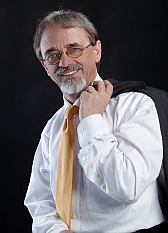Summary and Curriculum Vitae
Lecture
Compressed Sensing with Radar
The purpose of this lecture is to introduce the participants to aspects of compressed sensing to Radar and synthetic aperture radar (SAR).
Compressed Sensing (CS) techniques represent a mathematical framework for the detection and allocation of sparse signals with a reduction of the actually required number of sensors. Nowadays modern radar systems use high bandwidth, which is linked to high sample rates to fulfil the Shannon-Nyquist theorem condition, and a large number of single elements for phased-array antennas. Often only a small amount of target parameters are of interest, which raises the question of whether CS is not a good way to reduce data size, complexity, weight, power consumption, and cost of radar systems.
This lecture addresses some aspects of a CS-radar by presenting generic system architectures and implementation considerations. Three possible applications will be considered: pulse compression, radar imaging, and air space surveillance with array antennas.
About the Lectuerer

| Personal information | |
| First name, Surname: | Joachim Ender |
| Title: | Prof. Dr.-Ing. |
| Organisation: | Fraunhofer FHR |
Joachim Ender studied at the Westphalian Wilhelm University of Münster, Germany, Mathematics and Physics with the major topics "Measure and Integration Theory" and "Theoretical Physics".
He achieved the diploma in 1975 and joined the Research Institute for Radio and Mathematics (FFM) of the German Research Society for Applied Sciences (FGAN) in 1976, where he worked on statistical theory of detection and estimation, phased array antennas, imaging radar, radar signal processing problems, and the design and construction of experimental radar systems.
He received the Dr.-degree at the Ruhr-University Bochum in electrical engineering. Since 1992 he is giving annular lectures on radar signal processing at the Ruhr-University, where he received the award "Honorary Professor" in 2002. He also gives lectures on radar techniques at the RWTH Aachen University, Aachen and the University of Siegen. J. Ender designed the "Airborne Experimental Radar" (AER) and supervised its building up, developed a command & control and a mission planning & execution software, operated this system in a couple of flight campaigns and investigated various techniques like spotlight SAR with electronically scanned antenna, high-resolution wide-scan mode, azimuth ambiguity suppression, jammer suppression and image generation under jamming conditions, multi-baseline across-track interferometry, along-track interferometry, ground moving target indication via post-Doppler STAP. He designed also the basic structure of the following-up system PAMIR (Phased Array Multifunctional Imaging Radar) with a wideband phased array antenna, additional modes like sliding mode, scan-MTI and ISAR for ground moving targets In 1999, he became the head of the department Electronic of the Research Institute for High Frequency Physics and Radar Techniques (FHR), where he coordinated the research activities for various aspects of phased array radar and imaging radar. Since 2003 he was the director of FHR. In August 2009 the FHR was taken over as a distinct institute of the Fraunhofergesellschaft (FhG) and was now called "Fraunhofer-Institut für Hochfrequenzphysik und Radartechnik". Joachim Ender continues to head this institute which is activating the engagement on the civilian markets. His current interests with respect to his own research are: Three-dimensional SAR, multi-channel SAR for ground moving target detection with air and space based radar including multistatic satellite constellations, bistatic SAR processing, MIMO-SAR and compressive sensing applied to radar.
He is speaker of the scientific board of ZESS (University of Siegen) and member of the scientific council of the international postgraduate program of the University of Siegen.
Joachim Ender is author and co-author of numerous papers and frequently serves as a referee for various international journals and conferences. He was one of the founder members of the "European Conference on Synthetic Aperture Radar" (EUSAR) and member of the program committee of a couple of radar-related conferences. In 2010 he was the general chairman of EUSAR and in 2011 he will be the general chairman of the international conference "Future Security". In 1991 he received the ITG award (shared with H. Wilden) for works on the "crow's nest antenna". He was together with colleagues awarded with the "Raytheon Radar Price" EuRAD 2005 for the "best radar paper". In 2007 he was one of the authors of a paper which was awarded the "GRS-S Transactions Prize Paper Award of the year 2006".
